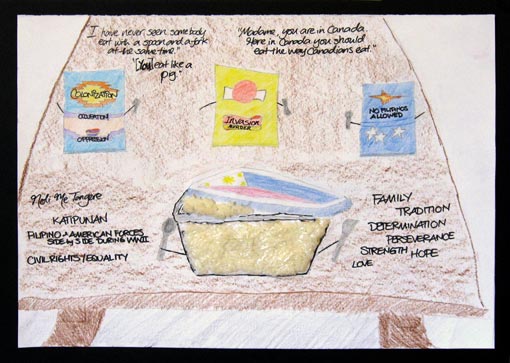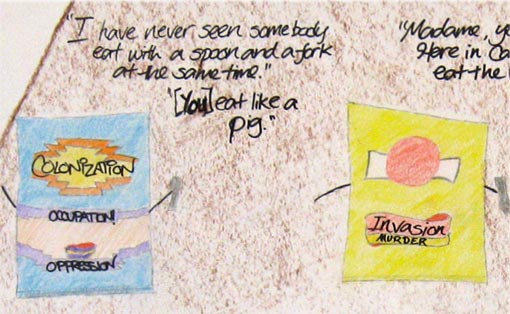
Continuing my throwback to my college days, here is my Project 2 piece for my Filipino-American Arts class. This project was entitled “Marginality as Resistance: ‘Writing’ Back to Center”.
The prompt had us consider Filipino and Filipino-American history, post-colonialism and transnationalism. And how art-making can be an act of inquiry, conversation and resistance.
For my piece, I recalled the controversy in Canada about a young Filipino-Canadian boy getting punished in school for eating with a spoon and fork.
You can read about the controversy here on Wikipedia.
Even now this story angers just thinking about it. Growing up in a Filipino home, it would have never crossed my mind that using both a fork and spoon would ever be somehow wrong. If anything, eating with a fork and spoon was the most proper way to eat as opposed to just using your hands.
It’s a fascinating discussion. While I love eating with my hands at home, I would absolutely feel uncomfortable eating with my hands in a restaurant or in public. Thus, in comes the fork and spoon. A more “civilized” way to eat in public.
A few years ago on The Ryzza Mae Show, Ryzza Mae had some etiquette “expert” on who taught her how improper it was to eat with both a fork and spoon and other “rules” I thought were absolutely absurd. And to be perfectly honest, if I were ever to take part in a meal that required such “etiquette” to eat, I would want nothing to do with it. #sorrynotsorry! And it’s not like I’d ever be invited to such a gathering anyway.
But using a fork and spoon, it’s not like I’m shoveling food into my mouth like some kind of forklift at a construction site.
Well, anyway. “You do you” is all I say. For me, I think I know how to “eat properly” depending on the situation. And that has nothing to do with a fork or spoon.
Here is my piece with an excerpt from my artist statement:


I decided to use the story that happened in 2006 of a young Filipino child in Canada who was embarrassed and insulted at school for eating with a fork and spoon at lunch. When the mother went to the principal of the school, she was shocked by his comments referring to her son as “eating like a pig” and telling her “Madame, you are in Canada. Here in Canada you should eat the way Canadians eat.”
I used this scenario to illustrate the Philippines and Filipinos wanting to fight back and resist outside forces from changing or controlling them, specifically the Spanish and the Japanese, as well as discrimination and segregation in the United States and as it turns out, Canada. The words represent the different ways Filipinos have been able to fight back against these hurdles that they are presented with and still manage to move forward, one big reason being them staying true to their values and beliefs that they have held onto for generations.
Like I mentioned yesterday, I’m definitely not a visual artist. And I really can’t draw that well. Though I do wonder now why my drawing (and this was on a large poster board) does not have proper perspective. Perspective was one of my favorite topics in both my high school History of Christian Art and college Appreciation of Visual Art classes.
Anyway, my piece is inspired by the story of that Filipino-Canadian boy. And it’s a little more direct and literal than my Project 3 piece from yesterday. The Tupperware of rice (a typical balon/baon for young Filipino kids in America) uses the fork and spoon to defend itself against oppressors.
The oppressors here are represented by those three bags of potato chips with modified logos and only one piece of cutlery (which according to the Canadian school administrators, is the proper use of them). We start off with a bag of chips representing Spanish colonization and oppression of the Philippines. Then we have a bag of chips representing Japan’s brutal invasion of the Philippines during World War II. And finally, a bag of chips representing the segregation of and discrimination against Filipinos in the United States in the early 20th century.
If I were more artistically-inclined, there’s definitely an amazing piece with this concept. And I must say, 10 years later, I feel like I might have a more creative mind when it comes to stuff like this. But I feel like I got my message across alright.
